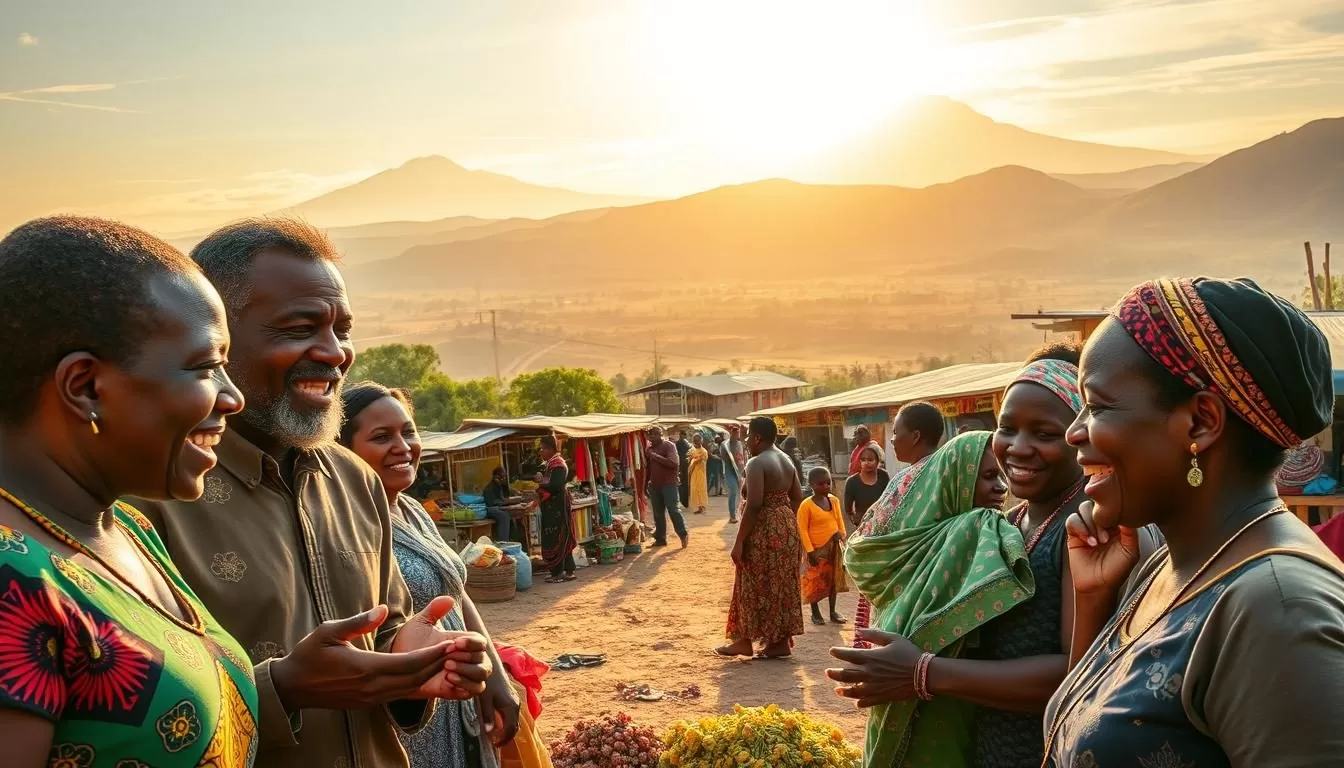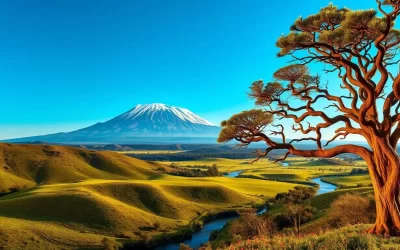Have you ever wondered how a single country can be home to over 120 languages? This East African nation is a linguistic treasure trove, reflecting its rich cultural heritage. Swahili, the national language, is spoken by nearly 95% of the population, serving as a unifying force across diverse communities.
From Sukuma in the north to Chaga near Mount Kilimanjaro, each language tells a story of tradition and identity. English also plays a role, especially in education and business, though it’s spoken by about 10% of the population. This blend of native and imported languages creates a unique cultural tapestry.
Understanding this linguistic diversity offers a glimpse into the heart of this vibrant country. Whether you’re exploring its history or planning a visit, knowing about its languages enriches your experience. Let’s dive deeper into this fascinating topic!
Introduction: Discover Tanzania’s Rich Linguistic Heritage
Step into a world where linguistic diversity paints a vivid cultural landscape. This East African nation is home to over 120 languages, each reflecting the unique identity of its speakers. From the bustling cities to the serene countryside, language serves as a bridge between tradition and modernity.
Overview of Tanzania’s Diverse Languages
The national language, Swahili, unites the population, while ethnic tongues like Sukuma and Chaga preserve local heritage. English plays a key role in education and business, making it a vital part of daily life. This blend of languages creates a unique cultural tapestry.
Historical Context and Cultural Richness
Post-independence policies shaped the way languages are used today. Swahili became a unifying force, while ethnic languages continued to thrive. This balance reflects the country’s commitment to preserving its rich history and traditions.
| Language | Role | Region |
|---|---|---|
| Swahili | National language | Nationwide |
| English | Education, business | Urban areas |
| Sukuma | Ethnic language | Lake Victoria |
| Chaga | Ethnic language | Mount Kilimanjaro |
Understanding this linguistic diversity offers a glimpse into the heart of this vibrant country. Whether you’re exploring its history or planning a visit, knowing about its languages enriches your experience.
Tanzania: Official and widely spoken languages
Language in this East African nation is more than just words—it’s a way of life. With over 120 tongues coexisting, communication becomes a cultural masterpiece. Swahili, the official language, unites nearly 90% of the population, while ethnic languages preserve centuries of tradition.
In daily life, Swahili dominates governance and education, but local dialects like Sukuma and Chaga thrive in their respective regions. English, spoken by fewer than 10% of the population, remains vital for trade and international relations. This blend creates a unique linguistic tapestry.
Ethnic languages, though less prominent, carry deep cultural significance. For example, the Maasai language is a cornerstone of identity in northern regions. These dialects are not just tools for communication but symbols of heritage and community pride.
Understanding this diversity is key to appreciating the country’s vibrant culture. Whether you’re exploring its history or engaging with its people, language offers a window into its soul. This linguistic richness is a testament to its enduring legacy.
Swahili: The Heart of Tanzanian Communication
Swahili is more than a language—it’s a cultural bridge. Originating from the coastal regions of East Africa, it has grown into a unifying force for millions of people. Today, it’s spoken by about 95% of the population, either as a first or second language.
Origins and Cultural Impact
Swahili’s roots trace back to the coastal areas, where it absorbed influences from Arabic, Persian, and English. This blend of linguistic elements makes it a unique and versatile language. It’s not just a tool for communication but a symbol of unity among diverse ethnic groups.
In everyday life, Swahili connects people across different regions. It’s a common thread in markets, homes, and social gatherings. This cultural impact has made it a cornerstone of identity for many communities.
Role in Education and Governance
Swahili plays a vital role in education and governance. It’s the primary language used in schools, courts, and government offices. This ensures that it remains accessible to the majority of the population, fostering inclusivity and understanding.
In schools, Swahili is a compulsory subject, helping students connect with their heritage while preparing them for modern challenges. In governance, it ensures that policies and laws are communicated effectively to all citizens.
| Aspect | Role of Swahili |
|---|---|
| Education | Primary language in schools |
| Governance | Used in courts and government offices |
| Daily Life | Unites diverse communities |
Swahili’s influence extends beyond borders, making it a key player in East Africa’s cultural and economic landscape. Its ability to bring people together is a testament to its enduring legacy.
English in Tanzania: Bridging Global and Local
English serves as a vital link between Tanzania and the global community. While Swahili unites the population, English connects the country to international trade, diplomacy, and tourism. Its role is especially prominent in urban centers and formal sectors, where it’s used in education, business, and legal systems.
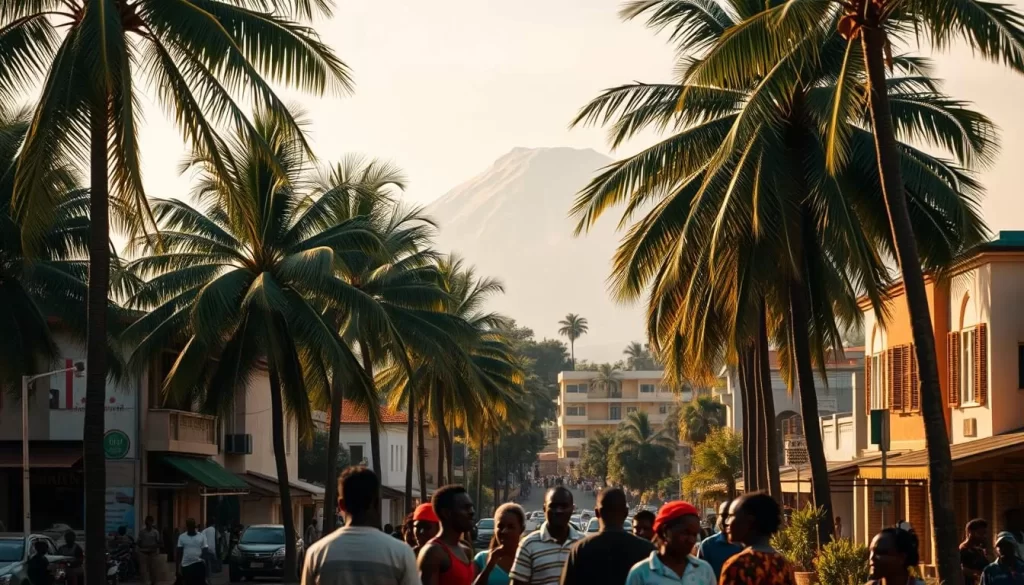
Around 10% of Tanzanians are proficient in English, making it less common in rural areas but essential in cities. This language reflects the country’s colonial past and its modern aspirations. It’s a tool for global communication, helping Tanzania engage with the world.
Role in Trade and International Relations
English is the language of choice for foreign trade and diplomacy. It ensures smooth communication with international partners, boosting economic growth. In tourism, English helps visitors navigate the country, making it a key part of the industry.
In education, English is taught in private schools, which have seen rising enrollments. However, recent reforms prioritize Swahili, creating a balance between local and global needs. This dual approach highlights Tanzania’s commitment to preserving its heritage while embracing global opportunities.
English’s role is pivotal in positioning Tanzania on the world stage. It bridges the gap between local traditions and international advancements, making it a cornerstone of the country’s progress.
Ethnic Languages and Their Cultural Significance
Discover the vibrant tapestry of ethnic languages that shape cultural identity. These native tongues are more than just a means of communication—they are a celebration of heritage and tradition. From Sukuma to Maasai, each language carries stories of pride and unity, connecting communities across the country.
Spotlight on Sukuma, Maasai, and Chaga Traditions
Sukuma, spoken by around 16% of the population, is a cornerstone of cultural expression in the Lake Victoria region. It’s used in traditional ceremonies, dances, and storytelling, preserving centuries of history.
The Maasai language, Maa, is spoken by approximately 800,000 people. It’s deeply tied to their pastoral lifestyle and oral traditions, which include songs, proverbs, and rituals.
Chaga, near Mount Kilimanjaro, is another vital language. It’s central to festivals and community gatherings, where elders pass down knowledge to younger generations.
The Social Value of Native Tongues
Ethnic languages reinforce identity and maintain community bonds. Despite the prominence of Swahili, these native tongues remain a source of pride. They are used in:
- Traditional ceremonies and festivals
- Oral histories and storytelling
- Daily interactions within local communities
For example, the Hadzabe language, spoken by a small hunter-gatherer community, is not considered at risk despite its limited number of speakers. This resilience highlights the deep cultural value of native tongues.
Understanding these languages offers a glimpse into the heart of this diverse nation. They are not just tools for communication but symbols of heritage and unity.
Regional Language Varieties and Local Dialects
From the coast to the highlands, language takes on distinct regional forms. Each area adds its unique flavor, creating a layered linguistic landscape. These variations enrich the cultural tapestry of the country, offering a glimpse into local identity and pride.
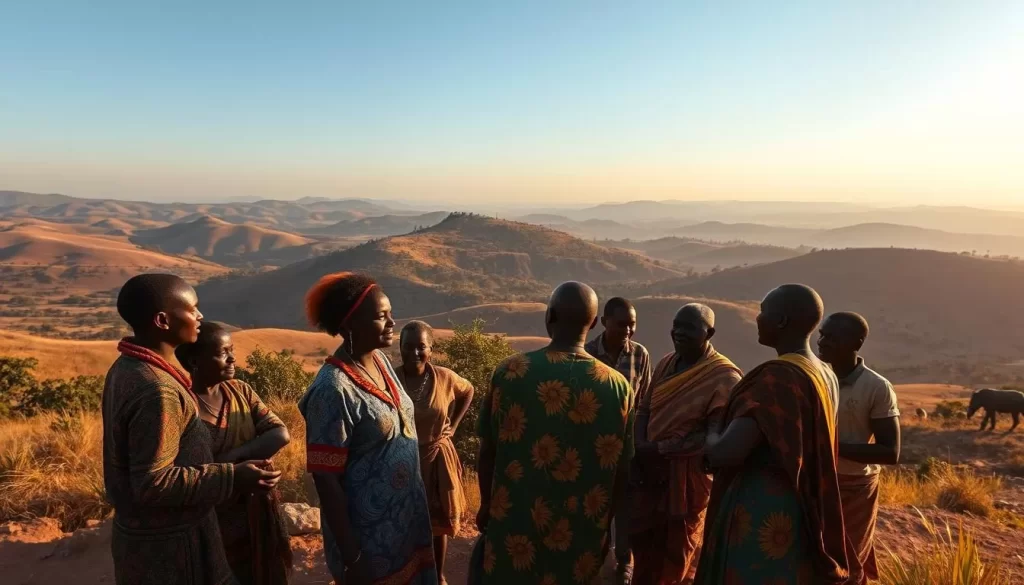
Exploring Unique Linguistic Features by Region
In the coastal areas, Swahili dialects like kiUnguja dominate, reflecting historical trade influences. Moving inland, you’ll find dialects such as kiMvita, which are common in urban centers. These differences aren’t just in vocabulary but also in accent and usage.
In the northern region, languages like Maasai and Chaga showcase unique grammatical structures. These dialects are deeply tied to cultural practices, from storytelling to traditional ceremonies. For example, the Maasai language uses specific terms to describe pastoral life, reflecting their way of living.
Here are some ways regional dialects influence daily life:
- Accents and pronunciation vary widely, even within the same language.
- Vocabulary changes to reflect local traditions and environments.
- Dialects are often used in community gatherings, strengthening social bonds.
These subtle differences highlight the pride each person takes in their regional identity. Whether you’re in the bustling cities or the serene countryside, language serves as a bridge between tradition and modernity.
Language Families in Tanzania: A Diverse Tapestry
Explore the intricate web of language families that shape communication in this vibrant nation. These families are the foundation of its linguistic diversity, each contributing unique elements to the cultural mosaic. Understanding them offers a deeper appreciation of how communities connect and thrive.
Bantu and Niger-Congo Contributions
The Bantu family is the most prominent, with over 95% of the population speaking languages from this group. Swahili, a Bantu language, serves as a unifying force across regions. Niger-Congo languages, though less widespread, play a vital role in daily interactions, especially in rural areas.
Nilotic and Khoisan Insights
Nilotic languages, like Maasai, are deeply tied to pastoral traditions and oral histories. Khoisan languages, though rare, are known for their unique click sounds. These languages highlight the rich heritage of smaller communities, preserving ancient ways of life.
Afro-Asiatic and Indo-European Influences
Afro-Asiatic languages, such as Cushitic, are spoken by smaller groups but hold cultural significance. Indo-European influences, primarily through English, bridge global and local communication. This blend of native and foreign languages reflects the country’s dynamic history.
By understanding these families, you gain insight into the country’s linguistic richness. Each language tells a story of identity, tradition, and connection. For more on Africa’s linguistic diversity, visit this resource.
The Influence of Colonization on Tanzania’s Language Landscape
The story of Tanzania’s languages is deeply tied to its colonial past. During the late 19th century, German and British rule reshaped how people communicated. These foreign powers introduced policies that prioritized certain languages over others, leaving a lasting impact.
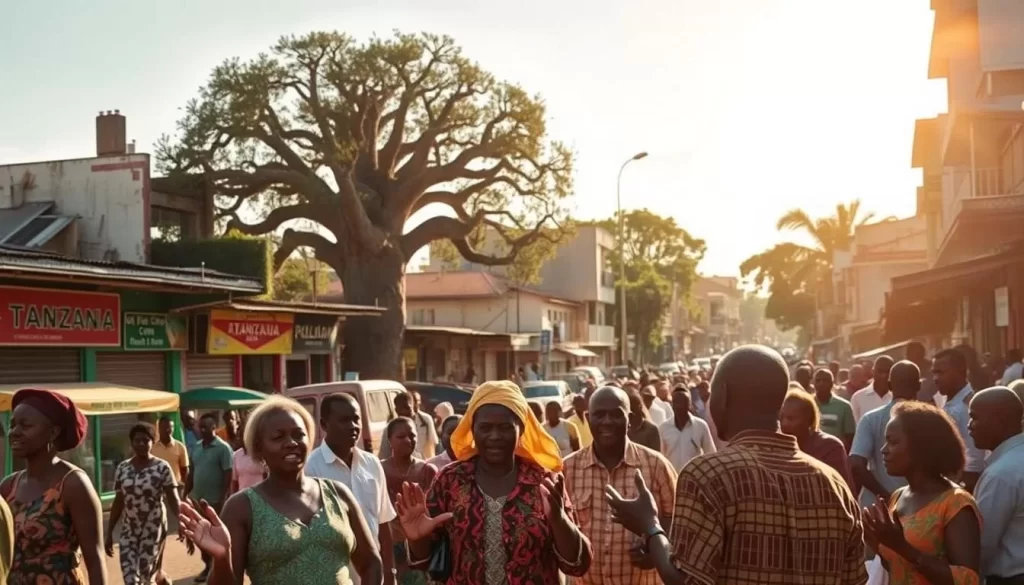
Under German rule, Swahili gained prominence as a lingua franca. It was used to bridge communication gaps between diverse ethnic groups. After World War I, British administration further solidified Swahili’s role, while also promoting English for governance and trade.
Historical Shifts in Language Use
Colonization brought significant changes to language policies. Swahili became a unifying force, while English was introduced as a tool for international relations. This dual approach aimed to streamline administration but also marginalized many indigenous languages.
For example, the British prioritized English in education and legal systems. This created a divide between urban and rural areas, where English was less commonly spoken. Meanwhile, Swahili continued to thrive as a national language, fostering unity across the country.
The colonial legacy also affected the survival of native tongues. Many ethnic languages faced challenges as Swahili and English dominated public spaces. However, these indigenous languages remain vital for cultural identity and community pride.
| Period | Language Policies | Impact |
|---|---|---|
| German Rule (1880s-1919) | Promoted Swahili as a lingua franca | Unified diverse ethnic groups |
| British Rule (1919-1961) | Introduced English for governance | Created urban-rural language divide |
| Post-Independence | Formalized Swahili as national language | Strengthened national identity |
Today, Tanzania’s linguistic landscape reflects this dual legacy. While Swahili and English dominate, efforts to preserve indigenous languages continue. For more insights on how colonization shaped language use, explore this detailed analysis.
Preserving Tanzania’s Linguistic Heritage
The rich tapestry of linguistic heritage in this East African nation faces modern challenges. With over 130 languages spoken, many are at risk of extinction due to shifting societal priorities. This section explores the hurdles in maintaining local tongues and the strategies to revive them.
Challenges in Maintaining Local Languages
One major challenge is the dominance of Swahili and English in education and media. These languages are often preferred, pushing local dialects into smaller domains like home and community gatherings. As a result, younger generations are less likely to learn their ancestral tongues.
Another issue is the breakdown of multigenerational social structures. Oral traditions, once passed down through families, are fading as urban migration increases. This shift disrupts the transmission of cultural knowledge tied to these languages.
Strategies for Cultural Revival
Efforts to preserve linguistic heritage are gaining momentum. Grassroots initiatives, like the “Talking the Walk” project, document local stories and plant knowledge in native languages. These projects aim to create written records that can be shared with future generations.
Government policies also play a role. While some have hindered language preservation, others are now supporting cultural revival. For example, educational reforms are beginning to include local dialects in school curricula.
| Strategy | Impact |
|---|---|
| Documentation Projects | Preserves oral traditions and knowledge |
| Educational Reforms | Introduces local languages in schools |
| Community Workshops | Encourages intergenerational learning |
By understanding these challenges and strategies, you can appreciate the efforts to maintain this vibrant linguistic heritage. For more insights, explore this resource on cultural diversity.
Education and Media: Language in Modern Tanzania
In modern Tanzania, the shift in language use within education and media has sparked significant cultural and societal changes. Over recent decades, the transition from native languages to dominant tongues like Swahili and English has reshaped how communities communicate and identify themselves.

The Transition from Native Languages to Dominant Tongues
Educational reforms have played a pivotal role in this transformation. Swahili is the primary medium of instruction in primary schools, while English dominates secondary and post-secondary education. This shift has created a dual-language system, where students often struggle to balance their native tongues with the demands of formal education.
For example, a 1978 study highlighted concerns about the effectiveness of English as the sole medium of instruction in secondary schools. This led to recommendations for a bilingual approach, blending Swahili and English to better support students’ academic and linguistic development.
Impact on Community, Identity, and National Policy
The media has also influenced public perception of language. Swahili dominates radio, television, and print media, reinforcing its role as a unifying force. However, English is often associated with higher social status and economic opportunities, creating a divide between urban and rural areas.
This transition has impacted community bonds and the preservation of native tongues. As younger generations prioritize Swahili and English, many indigenous languages face the risk of fading away. This loss of linguistic diversity threatens cultural heritage and identity.
“Language is not just a tool for communication; it is the soul of a community.”
Efforts to address this issue include educational reforms and community initiatives. For instance, the Presidential Commission on Education recommended increasing the use of Swahili in secondary classrooms to bridge the gap between tradition and modernity.
| Aspect | Impact |
|---|---|
| Education | Dual-language system with Swahili and English |
| Media | Swahili dominates, while English signifies status |
| Community | Risk of losing native languages and cultural identity |
Understanding this balance between modern communication needs and cultural continuity is essential. For more insights on bilingual education strategies, explore this detailed analysis.
Community, Trade, and Identity: The Role of Language
Language shapes how we connect, trade, and define ourselves in society. It’s the glue that binds communities, the tool that drives commerce, and the mirror that reflects our shared identity. From casual conversations to formal negotiations, language plays a pivotal role in every aspect of life.
Building Bonds Through Communication
In every community, language fosters trust and understanding. It’s how people share stories, celebrate traditions, and resolve conflicts. For example, in East Africa, Kiswahili serves as a bridge between diverse ethnic groups, creating a sense of unity.
Whether it’s a family gathering or a neighborhood meeting, the words we choose strengthen relationships. They help us express emotions, share ideas, and build lasting connections.
Language in Trade and Commerce
Trade thrives on clear communication. In markets and businesses, language ensures smooth transactions and fosters partnerships. Kiswahili, for instance, is widely used in cross-border trade across East Africa, making it a vital tool for economic growth.
From negotiating deals to marketing products, the right words can open doors to new opportunities. They bridge cultural gaps and create a shared understanding between buyers and sellers.
Creating a Shared Identity
Language also shapes how we see ourselves and others. It’s a marker of identity, reflecting our heritage and values. In many cultures, native tongues are tied to traditions, rituals, and social norms.
For example, the Maasai language, Maa, is deeply connected to their pastoral lifestyle. It’s not just a way to communicate but a symbol of their cultural pride.
| Aspect | Role of Language |
|---|---|
| Community | Builds trust and understanding |
| Trade | Facilitates transactions and partnerships |
| Identity | Reflects heritage and cultural pride |
Understanding the power of language helps us appreciate its role in connecting people. Whether it’s in a bustling market or a quiet village, words have the power to unite, inspire, and transform. For more insights on how Kiswahili fosters integration, explore this resource.
Conclusion
The rich linguistic landscape of this East African nation reflects its cultural depth and unity. With over 100 languages spoken, it’s a testament to the country’s vibrant heritage. Swahili serves as a unifying force, while indigenous tongues preserve centuries of tradition.
Historical shifts, education, and media have shaped how language is used today. Swahili dominates daily life, while English connects the country to global opportunities. This balance highlights the importance of preserving native dialects alongside dominant tongues.
Efforts to maintain this linguistic diversity are crucial. By supporting cultural revival initiatives, we can ensure these languages continue to thrive. Explore more about East Africa’s linguistic heritage here.
The above is subject to change.
Check back often to TRAVEL.COM for the latest travel tips and deals.
Here are some Tours & Sightseeing suggestions that might pique your interests!
